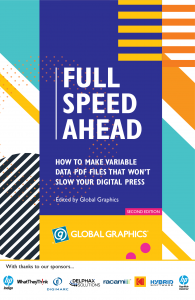At the beginning of 2020, in what we thought was the run-up to drupa, Global Graphics published a new guide called “Full Speed Ahead: How to make variable data PDF files that won’t slow your digital press”. It was designed to complement the recommendations available for how to maximize sales from direct mail campaigns, with technical recommendations as to how you can make sure that you don’t make a PDF file for a variable data job that will bring a digital press to its knees. It also carried those lessons into additional print sectors that are rapidly adopting variable data, such as labels, packaging, product decoration and industrial print, with hints around using variable data in unusual ways for premium jobs at premium margins.
Well, as they say, a lot has happened since then.
And some of that has been positive. At the end of 2020 several new International Standards were published, including a “dated revision” (a 2nd edition) of the PDF 2.0 standard, a new standard for submission of PDF files for production printing: PDF/X-6, and a new standard for submission of variable data PDF files for printing: PDF/VT-3.
We’ve therefore updated Full Speed Ahead to cover the new standards. And at the same time we’ve taken the opportunity to extend and clarify some of the rest of the text in response to feedback on the first edition.
So now you can keep up to date, just by downloading the new edition!
Further reading:
- What’s the best effective photographic image resolution for your variable data print jobs?
- Why does optimization of VDP jobs matter?
To be the first to receive our blog posts, news updates and product news why not subscribe to our monthly newsletter? Subscribe here

